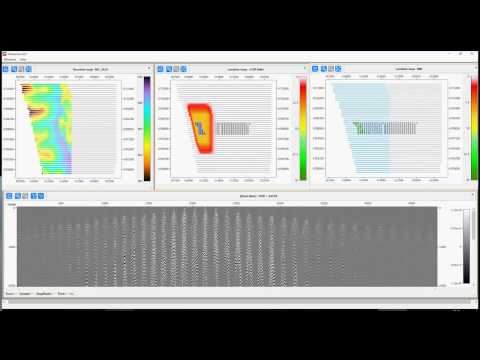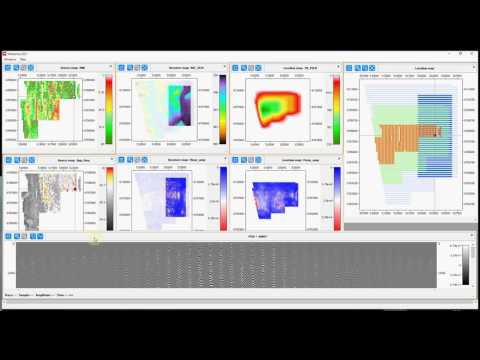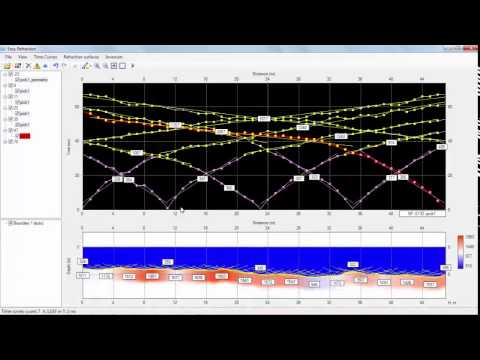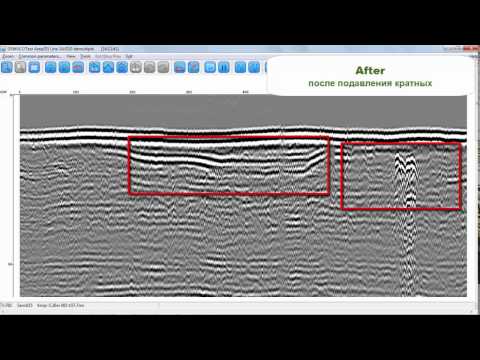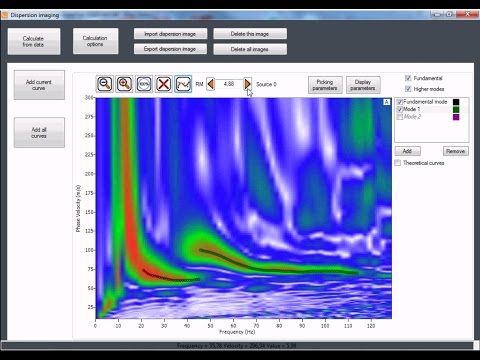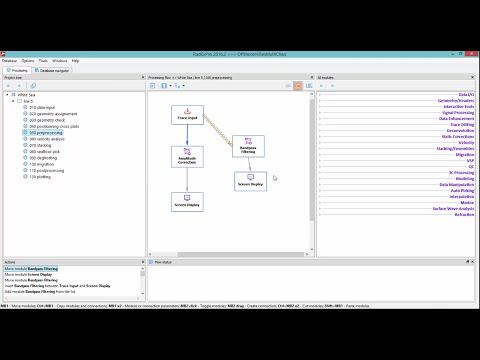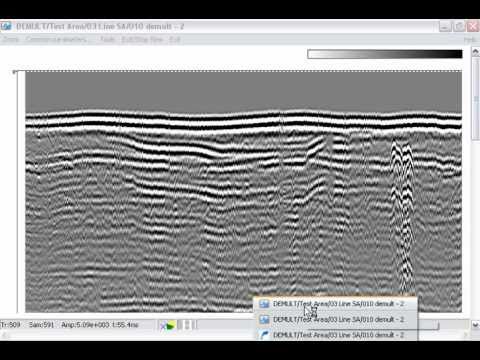RadExPro
RadExPro est un logiciel de traitement flexible et moderne, adapté pour le traitement des données marines HR/UHR, le traitement des données sismiques terrestres superficielles (réfraction, réflexion, MASW et VSP), ainsi que pour le contrôle qualité (QC) à grande échelle, y compris le traitement en temps réel et rapide.
Traitement des données sur les sols proches de la surfaceRadExPro permet l'imagerie des structures superficielles pour des levés sismiques de réflexion 2D et 3D terrestres, avec tout type de source (marteau, chute de poids, canon, vibrosismique, etc.).
Les algorithmes disponibles incluent : calcul des corrections statiques par réfraction, binage CDP pour lignes courbes, atténuation du bruit linéaire et aléatoire (filtres 3D inclus), SCAC (analyse spectrale), déconvolution, analyse automatique des statiques, analyse interactive des vitesses, migration avant et après sommation.
Les études de sismique réfraction sont largement utilisées pour les applications d'ingénierie sismique à faible profondeur. Les méthodes temps-retard et GRM (General Reciprocal Method) sont implémentées dans RadExPro.
RadExPro fournit un outil rapide et pratique de sélection automatique des premières coupures de données sismiques à utiliser pour une analyse plus poussée de la réfraction. Tous les résultats sont stockés dans une base de données et sont facilement accessibles. Le processus de construction des horizons de réfraction est entièrement interactif, ce qui permet de contrôler l'ensemble du processus, du début jusqu'à l'image finale. Cela permet d'éviter les pièges pendant le traitement et de construire la structure souterraine la plus pertinente.

L'analyse multicanal des ondes de surface utilise les propriétés de dispersion des ondes de Rayleigh pour établir le profil de vitesse des ondes de cisaillement (Vs) jusqu'à une profondeur de 30 m à des fins géotechniques diverses. La puissance des ondes de sol dans les enregistrements sismiques typiques permet d'utiliser leur énergie pour le MASW. La procédure générale de traitement MASW comprend le calcul de la courbe de dispersion, la sélection des modes fondamentaux et supérieurs, suivie de l'inversion. RadExPro dispose d'une routine MASW dédiée avec une interface conviviale, qui permet d'effectuer toutes les étapes à la suite jusqu'à la section finale de la Vs.
Études d'ingénierie par la méthode VSP (Profil sismique vertical)
Le traitement des données VSP et crosshole nécessite un flux de traitement efficace et sophistiqué. Le logiciel sismique RadExPro fournit tous les algorithmes nécessaires au traitement des données multi-composantes - analyse des hodogrammes, orientation des composantes 2C/3C, séparation des champs d'ondes, modélisation des vitesses, empilement corridor et liaison des puits avec les données sismique réflexion.
Traitement des données sismiques marines à haute résolutionRadExPro propose un ensemble complet d'algorithmes pour le traitement des données sismiques marines peu profondes, y compris des algorithmes modernes de débruitage, des corrections statiques, des techniques de désignature (débullage, déghostage adaptatif, mise en forme du signal), l'élimination des multiples (SRME), la soustraction adaptative, la régularisation 3D, les migrations pré-pile (PSTKM). De nombreuses routines ont été spécialement développées et adaptées au traitement des données à haute résolution.
Levés sismiques à grande échelleContrôle Qualité des Données (QC) :
Le contrôle qualité des données sur le terrain est une procédure standard lors des acquisitions pour l'industrie pétrolière et gazière, incluant la vérification de la qualité des données de position et des données sismiques ainsi que de leurs rélations. RadExPro propose divers outils, tels que l'analyse des données et du spectre dans des fenêtres définies par l'utilisateur, l'analyse des attributs et des affichages interactifs modernes pour un contrôle complet pendant le levé.

Le contrôle qualité des données en temps réel garantit que toutes les données acquises sont conformes aux spécifications du client. RadExPro dispose d'un système unique de lecture des fichiers de données, dès qu'ils arrivent sur le serveur, et les introduit dans les flux de contrôle de qualité, ce qui se traduit par un affichage immédiat sur chaque graphique de contrôle de qualité, sans aucun retard. L'ensemble des contrôles qualité (QC) est entièrement ajustable et peut être construit en fonction des spécificités du léve et des demandes du client. Des rapports finaux avec les cartes de contrôle qualité sont également disponibles. Un ensemble typique de produits de contrôle qualité comprend :
Contrôle qualité de la source – vérification des hydrophones en champ proche, amplitude du pic de bulle, rapport primaire-bulle.
Contrôle qualité des données – enregistrements de tirs, enregistrements de traces proches, analyse d’amplitude, analyse spectrale, cartes de canaux, empilement brut, etc.
Le traitement rapide et le traitement sur le terrain sont généralement effectués dans le cadre de la routine de contrôle de la qualité des données et pour une évaluation rapide de l'image sismique. Ce type de traitement s'effectue souvent parallèlement à l'acquisition, c'est-à-dire à bord des navires sismiques. La réplication et la parallélisation permettent aux processeurs d'effectuer des tâches de haute performance après l'achèvement de chaque bloc ou ligne et de fournir rapidement les résultats au client.
| Start | Professional / Real-Time | |
|
Entrée/Sortie des données |
||
| Données d'entrée provenant des fichiers SEG-Y, SEG-2, SEG-B, SEG-1, SCS-3, avec en-tête optionnel | + | + |
| Données d'entrée provenant des fichiers SEG-D et FairFieldNodal Receiver Gather, avec en-tête optionnel |
|
+ |
| Données GPR (LOGIS, Zond, RAMAC/GPR, GSSI, Pulse EKKO) | + | |
| Entrée de données provenant d'un fichier dans un format démultiplexé arbitraire, y compris les informations contenues dans les en-têtes de la trace | + | + |
| Lecture de données à partir de lecteurs de bandes | + | + |
| Sortie de données vers des fichiers SEG-Y avec la possibilité de redéfinir les en-têtes | + | + |
| Exportation de données vers un fichier texte ASCII | + | + |
| Attribution de géométrie | ||
| Importation à partir de fichiers de tableaux ASCII | + | + |
| Téléchargement depuis fichiers SPS et UKOOA P1-90 | + | |
| Calcul géométrique par formules mathématiques | + | + |
| Affichage et édition en mode tableur | + | + |
| Module interactif spécial pour l'introduction de la géométrie dans les données peu profondes | + | + |
| Module spécial pour la saisie de la géométrie marine | + | + |
| Module spécial pour la saisie de la géométrie du VSP | + | |
| Regroupement 2D et 3D le long d'un profil courbe arbitraire | + | |
| Calcul des corrections statiques | ||
| Calcul des corrections statiques pour le relief | + | + |
| Calcul des corrections statiques résiduelles pour les conditions de surface | + | |
| Calcul des corrections statiques par la méthode de la puissance maximale | + | |
| Calcul des corrections statiques de corrélation | + | + |
| Application de corrections statiques | + | + |
| Traitement des amplitudes | ||
| Ajustement de l'amplitude : linéaire (pour la divergence sphérique), exponentiel, contrôle automatique du gain (AGC), équilibrage du trajet, amplification variable dans le temps | + | + |
| Suppression du contrôle automatique du gain (AGC) | + | + |
| Alignement des amplitudes entre les ensembles | + | + |
| Elimination de la composante continue | + | + |
| Déconvolution et modification de la forme des spectres | ||
| Déterministe | + | + |
| Phase nulle | + | + |
| Prédiction | + | + |
| Blanchiment | + | + |
| Adaptation à la surface | + | |
| Prédictive non stationnaire | + | |
| Filtration prédictive F-X (déconvolution F-X) | + | |
| Isolation de l'impulsion de phase zéro | + | |
| Factorisation spectrale de Kolmogorov | + | |
| Blanchiment spectral | + | + |
| Changement de forme du spectre | + | |
| Exponentiation du spectre d'amplitude F-K / F-X | + | |
| Traitement multicomposant | ||
| Analyse des hodogrammes | + | |
| Rotation de 2 ou 3 composants | + | |
| Rotation de données à composantes multiples FairfieldNodal | + | |
| Interpolation | ||
| Interpolation des traces le long du profil avec un espacement régulier | + | + |
| Interpolation du système de profil sur une grille régulière (calcul du pseudo-cube) | + | |
| Régularisation F-Kx-Ky en 3D | + | |
| Travail avec des en-têtes | ||
| Opérations mathématiques sur les champs d'en-tête | + | + |
| Éditeur de tableurs | + | + |
| Importation à partir de fichiers ASCII, exportation vers des fichiers ASCII | + | + |
| Calcul de valeur moyenne par fenêtre glissante | + | + |
| Décalage des valeurs des champs d'en-tête vers un nombre spécifié de traces | + | + |
| Entrée et sortie des corrections cinématiques de la valeur de l'en-tête | + | + |
| Liaison de la valeur de l'en-tête à une surface (par exemple, décalages statiques ou amplitudes) | + | |
| Affichage des valeurs des champs d'en-tête sous forme de graphiques | + | + |
| Analyse des valeurs de l'espacement transversal et des histogrammes correspondants | + | |
| Combinaison d'ensembles de données | ||
| Soustraction / addition de deux ensembles de données | + | + |
| Intégration verticale de deux ensembles de données le long de l'horizon | + | |
| Filtrage et opérations sur les routes | ||
| Filtrage des fréquences : | ||
| filtrage par bandes avec un simple filtre trapézoïdal | + | + |
| Filtre Ormsby | + | + |
| Filtre Butterworth | + | + |
| filtre coupe-bande | + | + |
| Filtrage bidimensionnel | + | + |
| Filtrage F-K | + | + |
| Filtration prédictive F-X (déconvolution F-X) | + | |
| Déconvolution 3D F-X-Y | + | |
| Transformation de Radon | + | |
| Calcul du spectre d'amplitude | + | + |
| Calcul du spectre de phase | + | + |
| Calcul des fonctions d'autocorrélation et de corrélation croisée | + | + |
| Logarithme et exponentiation | + | + |
| Soustraction adaptative des champs d'ondes | + | |
| Convolution | + | + |
| Opérations arithmétiques trace / trace et trace / scalaire | + | + |
| Montée en puissance de la route | + | |
| Conversion en routes radiales (directes et inversées) | + | + |
| Suppression des interférences locales de grande amplitude (« émissions ») | + | + |
| Réduction du bruit dans le domaine des fréquences (atténuation du bruit TFD) | + | |
| Réduction du bruit dans le domaine fréquence-temps (manuel) | + | |
| Édition des traces | ||
| Rééchantillonnage des traces | + | + |
| Élimination des traces indésirables | + | + |
| Mise à zéro des sections de trace (muting) | + | + |
| Inversion de polarité | + | + |
| Modification de la longueur de la route | + | + |
| Conversion temps-profondeur | ||
| Conversion des données de l'échelle de temps à l'échelle de profondeur et vice versa à l'aide de différentes lois de vitesse | + | + |
| Migration et DMO | ||
| Migration temporelle de Kirchhoff 2D/3D avant et après sommation | + | |
| Migration F-K Stolta | + | + |
| Migration tridimensionnelle F-K Stolta | + | |
| Migration T-K | + | + |
| 2D F-K DMO | + | |
| Contrôle de qualité et analyse des attributs | ||
| Contrôle de qualité des sismogrammes OPV / OPP : calcul de l'amplitude moyenne et quadratique, du rapport signal/bruit, de la résolution et de la fréquence visible dans une fenêtre spatio-temporelle rectangulaire ou façonnée | + | |
| Contrôle de qualité des sismogrammes OPV / OPP : calcul de l'amplitude moyenne et quadratique, du rapport signal/bruit, de la résolution et de la fréquence visible dans une fenêtre spatio-temporelle rectangulaire ou façonnée | + | |
| Calcul de la multiplicité et de la distribution des délétions | + | |
| Cartes du système d'observation, multiplicités, distribution des suppressions | + | |
| Analyse de la relation entre les champs d'en-tête à l'aide de graphiques croisés et d'histogrammes | + | |
| Cartographie d'attributs avec un substrat cartographique | + | |
| Estimation de l'amplitude moyenne dans la fenêtre, de l'amplitude quadratique moyenne dans la fenêtre, de la valeur maximale de l'amplitude, de la valeur minimale de l'amplitude, de la valeur absolue maximale de l'amplitude | + | |
| Détermination du temps correspondant à la valeur maximale, minimale, absolue maximale de l'amplitude | + | |
| Détermination de la fréquence dominante et apparente, de la fréquence centroïde, du spectre de largeur sur la section totale dans la fenêtre le long de l'horizon | + | |
| Détermination du rapport signal/bruit sur la section totale dans la fenêtre le long de l'horizon | + | |
| Calcul de l'ACF et du FVK | + | |
| Détermination interactive des vitesses de tous les types d'ondes | + | + |
| Calcul de la fréquence instantanée, de l'amplitude instantanée et de la phase instantanée | + | |
| Cartes interactives des attributs | + | |
| Vitesses et sommation des CDP | ||
| Binning de données 3D sur des points médians communs | + | |
| Binning 2D le long de la CDP le long d'un profil curviligne arbitraire | + | |
| Formation des sismogrammes OGT | + | + |
| Formation de supersismogrammes | + | + |
| Recalcul des lois sur la vitesse | + | |
| Analyse interactive des taux de sommation des CDG | + | + |
| Analyse de la vitesse pororizontale | + | |
| Calcul et saisie des corrections cinématiques | + | + |
| Sommation des CDP | + | + |
| Traitement des données marines | ||
| Saisie de la géométrie dans les données marines | + | + |
| Importation de géométrie à partir de fichiers UKOOA P1-90 | + | |
| Correction des tirs accidentels et manqués | + | + |
|
Importation de corrections statiques pour les marées |
+ | |
| Calcul des corrections statiques pour la sismoacoustique marine | + | |
| Suppression des pulsations répétées de la chambre à air | + | |
| Suppression des ondes multiples grâce à la technologie SRME 2D | + | |
| Suppression de la sismo-acoustique multiple avec de petites suppressions dans les données | + | |
| SharpSeis™ : suppression adaptative des ondes satellitaires / traitement à large bande | + | |
| MPW | ||
| Traitement des courbes de déplacement des ondes réfractées par la méthode MPW (t0 et GRM) | + | + |
| Traitement des premières arrivées d'ondes réfractées | + | + |
| Analyse des ondes de surface | ||
| Construction d'un modèle de vitesse des ondes transversales dans la partie supérieure de la section à l'aide de l'analyse multicanal des ondes de surface (MASW) | + | + |
| Vibroseis | ||
| Corrélation | + | + |
| VSP | ||
| Saisie de la géométrie et de l'inclinométrie dans les données VSP | + | |
| Analyse des hodogrammes, rotation 2C et 3C | + | |
| Séparation des champs d'ondes | + | |
| Calcul du temps d'arrivée d'une onde directe ou réfléchie à partir d'un horizon donné pour un modèle à couches horizontales | + | |
| Construction d'un modèle de vitesse en couches | + | |
| Calcul du temps d'arrivée d'une onde directe ou réfléchie à partir d'une frontière réfléchissante donnée pour un milieu à couches horizontales | + | |
| Corrections cinématiques de la VSP non longitudinale | + | |
| Importation de données d'enregistrement, importation et exportation de modèles de vitesse | + | |
| Modèles de vitesse de chargement et de déchargement, enregistrement des données | + | |
| Interprétation conjointe des données VSP, SIG et sismiques | + | |
| Migration Kirchhoff des sismogrammes VSP | + | |
| Transformation VSP-OGT | + | |
| Visualisation et impression | ||
| Visualisation de données par différentes méthodes | + | + |
| Affichage des traces par la méthode des déviations sur le champ de vitesse ou de données, dérivée par la méthode de la densité variable | + | + |
| Visualiser et comparer plusieurs profils simultanément | + | + |
| Synchronisation des échelles, des barres de défilement et de l'amplification entre plusieurs fenêtres pour une comparaison pratique des données | + | + |
| Calcul interactif du spectre d'amplitude de n'importe quel fragment de données | + | + |
| Affichage de plusieurs spectres dans une fenêtre | + | + |
| Visualisation des valeurs des champs d'en-tête | + | + |
| Affichage sur la carte des profils, des attributs, des horizons, etc. | + | + |
| Visualisation d'une section sismique le long d'une ligne arbitraire à partir d'une carte | + | + |
| Ajout d'objets linéaires à des sections dans un espace tridimensionnel | + | + |
| Exportation d'un projet croisé, d'histogrammes de champs d'en-tête vers une image bitmap | + | |
| Impression des résultats du traitement avec aperçu | + | + |
| Visualisation 3D | ||
| Visualisation d'un cube en 3D | + | |
| Gestion des données et des flux | ||
| Traitement au sein des projets. Les projets peuvent être facilement transférés avec toutes les données et tous les paramètres | + | + |
| Capacité à travailler simultanément sur plusieurs projets | + | + |
| Créer des files d'attente pour les fils de traitement en vue d'une exécution parallèle | + | + |
| Copie des fils de traitement avec toutes les procédures et tous les paramètres | + | + |
| Exportation / importation de flux de traitement entre projets | + | + |
| Histoire du traitement | + | + |
| Exécution d'une série de procédures de traitement avec différents paramètres afin de comparer les résultats | + | + |
| Réorganisation des données au cours du traitement | + | + |
| Re-tri rapide de grandes quantités de données au cours du processus | + | |
| Combinaison de plusieurs fils d'exécution dans une file d'attente, exécution simultanée en rafale | + | |
| Traitement par lots de la liste des fichiers dans un seul thread | + | |
| Interpolation / extrapolation des horizons | + | |
| Interprétation | ||
| Suivi des réflexions en mode manuel et automatique | + | + |
| Construction d'une grille sur les horizons ou attributs empalés | + | + |
| Calcul des attributs le long des horizons | + | |
| Analyse et comparaison simultanées de différents types de données sur une carte et dans un espace tridimensionnel | + | |
